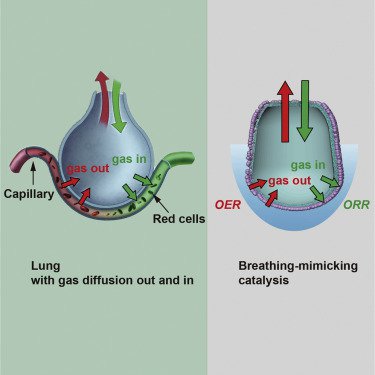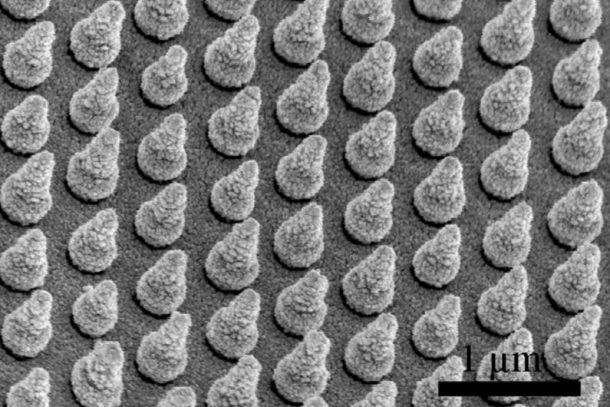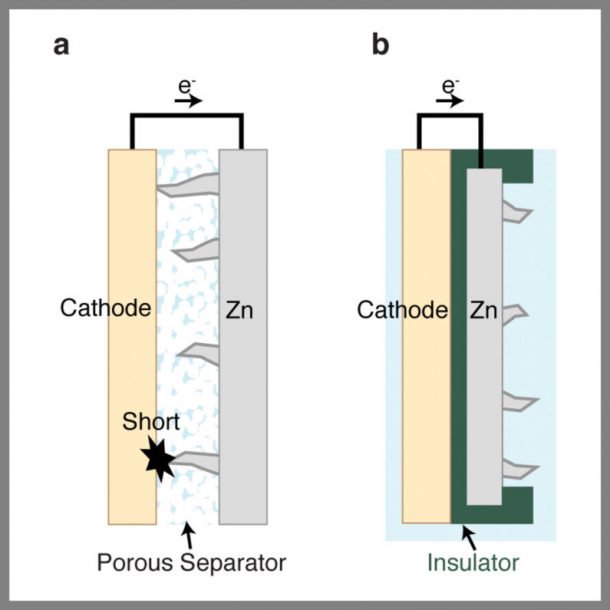A team of scientists at Stanford University have developed a revolutionary new electrocatalytic device that works like a human lung as it transforms water into a clean source of hydrogen fuel.
Their research, published in the journal Joule, could improve the efficiency of existing clean energy technologies.
After air enters a human lung it passes through the alveolus, a membrane that extracts oxygen from air and sends it into the bloodstream. Yi Cui and his team of researchers at the Department of Materials Science and Engineering, found that by mimicking this process with a pouch created out of a thick plastic film, water, and an electrode, they were able to increase electrocatalytic oxygen evolution and reduction by 32 percent, which increases the rate of chemical reactions used to produce hydrogen. Using a device that is 100 times thinner than a human hair, the team hopes to generate more hydrogen fuel – a clean energy source that has the potential to one day power everything from cars to smart phones.
Scientists at Stanford University have designed an electrocatalytic mechanism that works like a mammalian lung to convert water into fuel. It could help existing clean energy technologies run more efficiently. https://t.co/OUtTxeCC23
— SCB (@Society4ConBio) December 22, 2018
Yi Cui’s team is now focusing on scaling-up their design by researching ways to increase the design’s tolerance of higher temperatures in an effort to make it more viable for commercial production. The team believes that by using nanoporous hydrophobic membranes capable of withstanding greater heat, they will be able to expand its potential applications. Jun Li, the study’s first author notes:
“The breathing-mimicking structure could be coupled with many other state-of-the-art electrocatalysts, and further exploration of the gas-liquid-solid three-phase electrode offers exciting opportunities for catalysis.”

This isn’t the first time Cui’s team has made a major breakthrough in the use of hydrogen fuel technology. In 2016, the Stanford engineers created arrays of silicon nanocones to trap sunlight and improve performance of solar cells made of bismuth vanadate.
“Nanocone structures have shown a promising light-trapping capability over a broad range of wavelengths,” Cui noted. “Each cone is optimally shaped to capture sunlight that would otherwise pass through the thin solar cell.”

The team’s breakthrough helped improve the production of hydrogen power and could help solve the problem of grid-scale energy storage by reducing corrosion in rechargeable zinc batteries in the future. Shougo Hitashi, the study’s lead author, explained:
“With our design, zinc ions are reduced and deposited on the exposed back surface of the zinc electrode during charging. Therefore, even if zinc dendrites form, they will grow away from the nickel electrode and will not short the battery.”

Unlike fossil fuels, the only byproduct of using hydrogen fuel is water. For this reason, scientists have researched hydrogen fuels for decades but have yet to find an economically viable process in which to produce it. Now, thanks to the research of Yi Cui and his team, the future of hydrogen energy is looking more promising.
As the global energy paradigm continues shifting away from fossil fuels toward clean and renewable energies, it is important to note that the economic viability of fossil fuels has been artificially propped up by governments that are beholden to corporate interests. According to a study published in the World Development journal, fossil fuel subsidies amounted to $5.3 trillion dollars in 2015, rising from $4.9 trillion in 2013. This amounts to 6.5 percent of global GDP. The Union of Concerned Scientists has also found that the hidden cost to human health is estimated at $74.6 billion a year.
The positive environmental impact of radical technologies like the Stanford team’s device cannot be understated. While lawmakers continue to pay lip service to the issue of global warming, this technology could drastically reduce the carbon footprint of the entire planet. Mountaintop coal removal is destroying entire swaths of land, oil sands developments are on track to causing the second fastest rate of deforestation, and hydraulic fracturing for oil & natural gas, also known as fracking, can require up to 15.8 million gallons of water per well.
In 2012, the total energy output from wind power alone in the United States surpassed 60 gigawatts, enough to power nearly 15 million homes. Meanwhile, renewable energy sources such as wind, solar, and hydro continue to be widely criticized as an inefficient means at meeting the nation’s energy demands. A promising new device called Triton is already challenging criticisms of tidal power. Triton, a device created by Oscilla Power, is estimated to be able to power one-third of the U.S. without the need for underwater motors or running parts. Through the use of revolutionary new technologies like the Stanford team’s device and Triton, we will soon be able to meet our energy needs without the use of fossil fuels.
Source: themindunleashed.com






